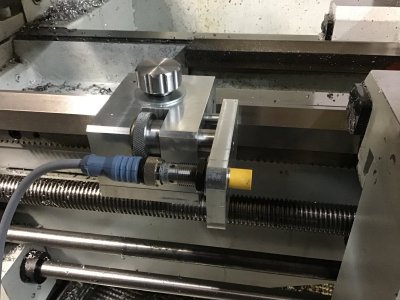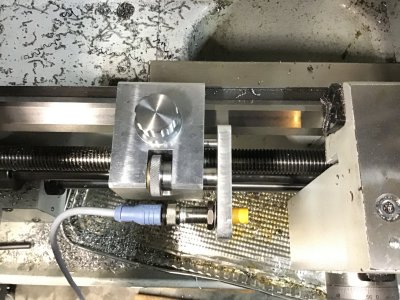I have been experimenting with using a proximity stop sensor for threading on my lathe. I usually do metric threads and have some left hand tools to thread away from the chuck, but decided to use what I had on hand to make a micrometer stop for a proximity sensor to use my right hand insert internal threading bar instead of buying a left hand version.
I took inspiration from several of the designs I saw here and came up with the bracket shown below. I had a proximity sensor on hand that I used with this, it’s not ideal, but good enough that it will work for now. I used a 1/2” rod with an M12x1 thread for positioning the bracket holding the sensor. I haven’t engraved the thumb wheel yet with index marks, but maybe some day. I used a guide rod to keep the sensor bracket from rotating and helps keep it square. A single screw clamps it to the lathe ways with a bracket on the bottom.


For the controls, I did not have room in my junction box for another relay, so I tore all that out and installed an Allen Bradley Micrologix 1000 PLC that I had in my parts bin to do the controls of my lathe. The nice part about using a PLC is I can quickly make any changes I want. I’ll probably need to upgrade the PLC to a different brand when my laptop dies and I no longer have a working copy of the programming software, AB software is stupid expensive. I have a selector switch on the lathe, off is normal operation with a 3 second stop time, and when on, engages the proximity sensor system, sets the lathe speed to 50%, and reduces the deceleration time to 0.3 seconds. I don’t have a potentiometer for speed setting yet, that’s in my shopping cart at McMaster for when I place my next order. I still need to install a light with the switch so that it is obvious when threading is engaged. When the sensor is tripped, it locks out forward operation until reset. Since I do mostly metric threads, I need to keep the half nuts engaged, so I programmed the PLC to release the stop latch when the lathe is put in reverse instead of using a push button to override it. This avoids the possibility of pressing an override button and going forward.
I have some small left hand threading tools for internal threads that I use for threading away from the chuck, I discovered the proximity stop is useful for those too. I can run the carriage to the starting point at full speed instead of getting close and using the jog to position it, then since only reverse will work, there is no danger of crashing the tool by moving in forward by mistake when cutting the thread.
I took inspiration from several of the designs I saw here and came up with the bracket shown below. I had a proximity sensor on hand that I used with this, it’s not ideal, but good enough that it will work for now. I used a 1/2” rod with an M12x1 thread for positioning the bracket holding the sensor. I haven’t engraved the thumb wheel yet with index marks, but maybe some day. I used a guide rod to keep the sensor bracket from rotating and helps keep it square. A single screw clamps it to the lathe ways with a bracket on the bottom.


For the controls, I did not have room in my junction box for another relay, so I tore all that out and installed an Allen Bradley Micrologix 1000 PLC that I had in my parts bin to do the controls of my lathe. The nice part about using a PLC is I can quickly make any changes I want. I’ll probably need to upgrade the PLC to a different brand when my laptop dies and I no longer have a working copy of the programming software, AB software is stupid expensive. I have a selector switch on the lathe, off is normal operation with a 3 second stop time, and when on, engages the proximity sensor system, sets the lathe speed to 50%, and reduces the deceleration time to 0.3 seconds. I don’t have a potentiometer for speed setting yet, that’s in my shopping cart at McMaster for when I place my next order. I still need to install a light with the switch so that it is obvious when threading is engaged. When the sensor is tripped, it locks out forward operation until reset. Since I do mostly metric threads, I need to keep the half nuts engaged, so I programmed the PLC to release the stop latch when the lathe is put in reverse instead of using a push button to override it. This avoids the possibility of pressing an override button and going forward.
I have some small left hand threading tools for internal threads that I use for threading away from the chuck, I discovered the proximity stop is useful for those too. I can run the carriage to the starting point at full speed instead of getting close and using the jog to position it, then since only reverse will work, there is no danger of crashing the tool by moving in forward by mistake when cutting the thread.

